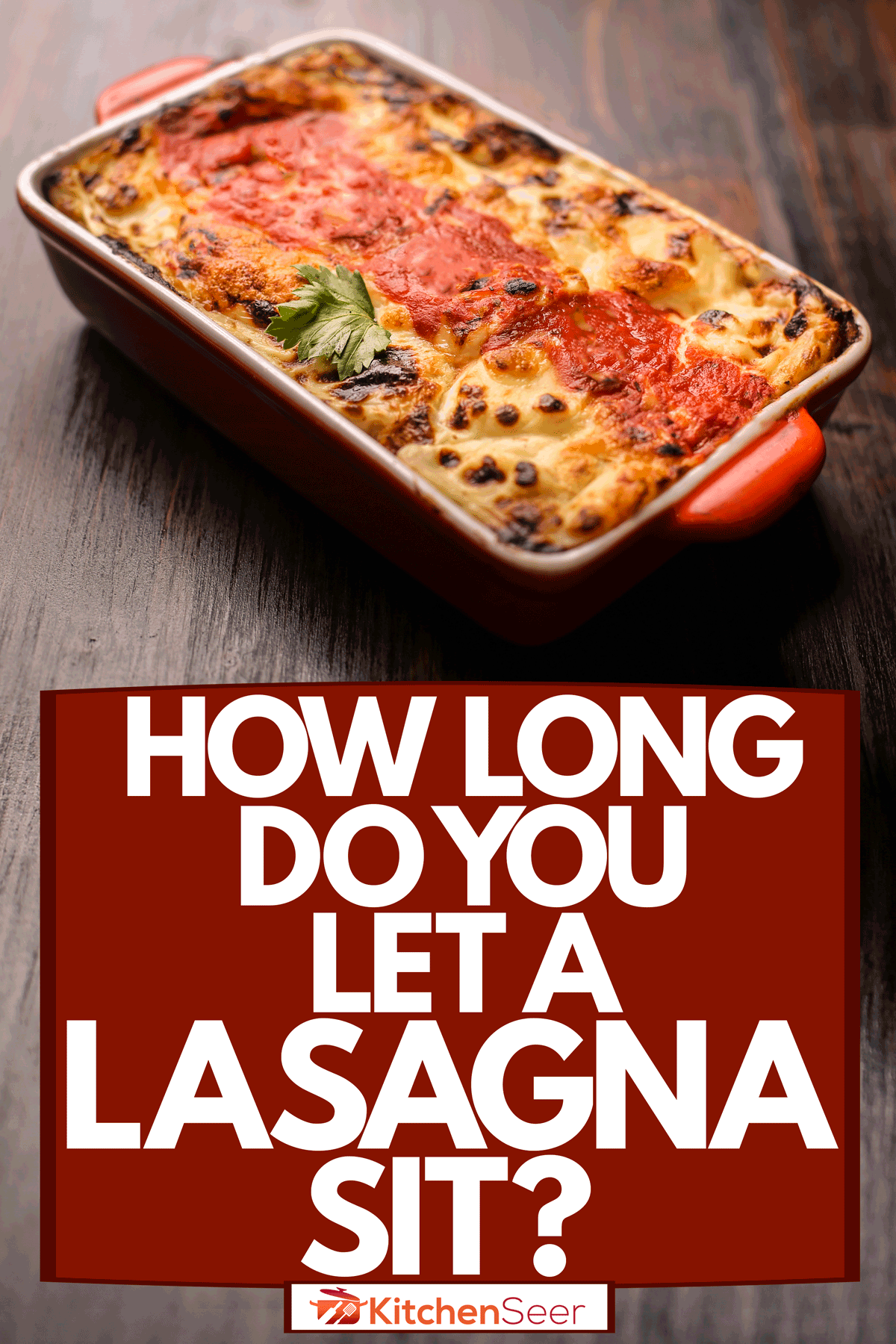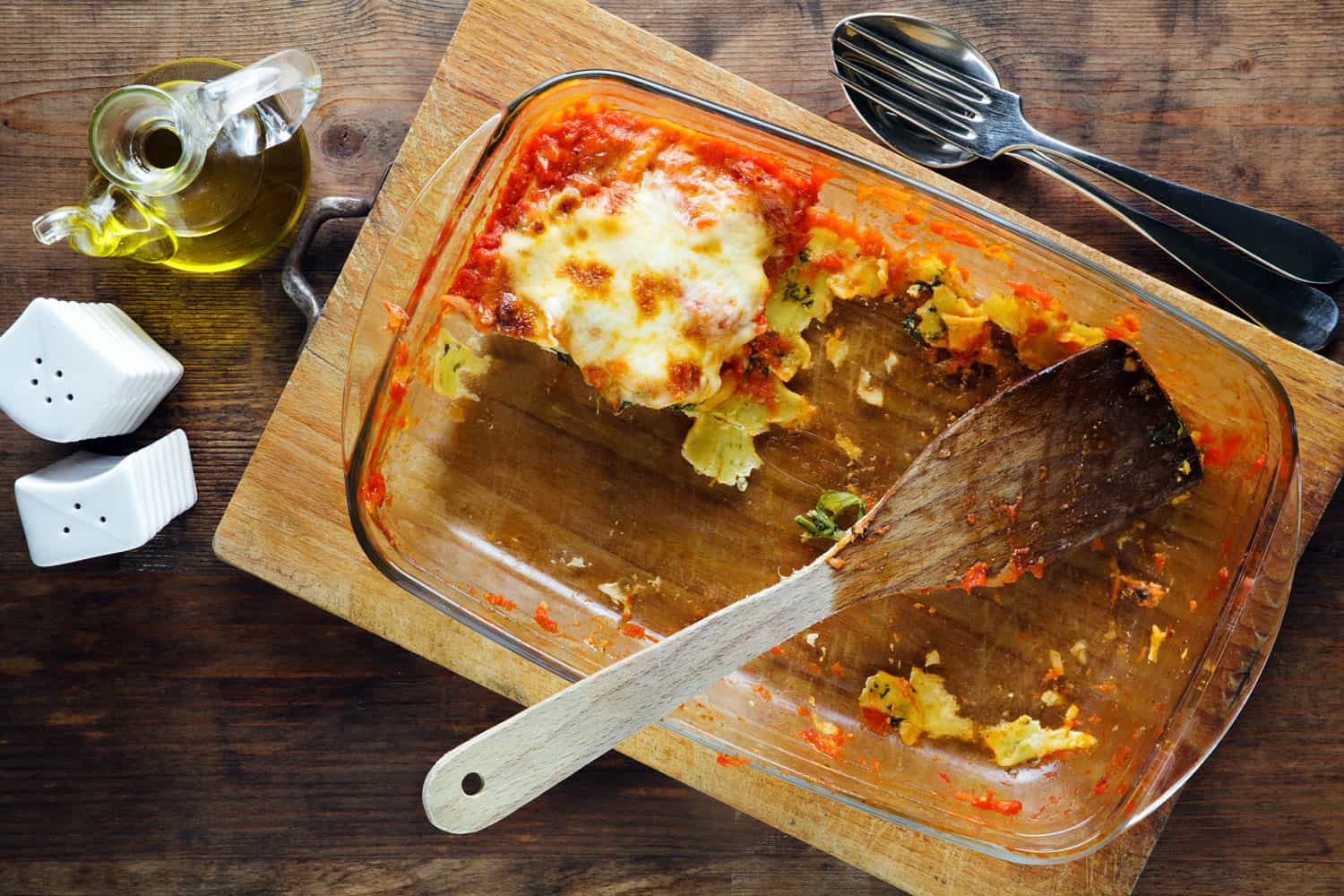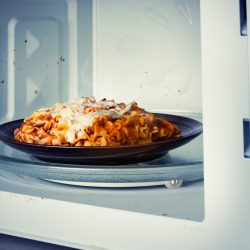You took your time assembling all of the delicious, saucy layers of your lasagna and suffered the pangs of hunger while it baked. When you pull it out of the oven, you might be tempted to dive into its bubbling cheesy deliciousness, but hold up! The final step to perfect lasagna is to let it sit after baking. But how long is long enough? We researched to find out just how much longer you have to wait before slaking your appetite.
Depending on the size and thicknesses of your lasagna, you should wait 10 to 20 minutes before serving it.
Dishing out the perfect lasagna is an art, and we have all the details so that yours becomes your family's new favorite meal. Keep reading for all the details!

How Long Do You Let a Lasagna Sit?

Allowing your lasagna to sit for 10 to 20 minutes after taking it out of the oven is a crucial step in lasagna perfection. The exact length of time you let it sit depends on how large and thick it is, so be sure to follow the recommendation in the recipe.
It is even better to cook your lasagna the day before and let it chill in the refrigerator overnight. The layers will all set together, and the dish can be reheated without fear of it falling apart.
Why does lasagna need to rest?
Allowing your lasagna time to rest adequately is the difference between a beautifully layered pasta dish and a sloppy mess. Allowing the dish to rest lets it cool enough for the components to set up. If you cut it too soon, the cheese layers will still be molten, and the layers of your slice will slide right off the spatula instead of holding together.
How do you know when lasagna is ready?
When your oven is nearing the end of the time recommended in your lasagna recipe, you need to know when it is actually ready to come out. There are a couple of different ways to tell that it is finished cooking, depending on how you crafted your dish.
If you precooked the lasagna noodles in the traditional fashion, then your lasagna is ready when you can see the sauce bubbling between the edges of the pan and the noodles. The top layer of cheese will also be melted and a light golden brown.
Lasagna made of 'oven-ready' noodles is not ready until a toothpick can easily be inserted into the middle.
Does lasagna have to be covered with foil for baking? to rest?
Knowing when to cover and uncover your lasagna is essential to the success of your dinner.
When cooking, you need to cover your lasagna with foil until the last 20 minutes of cooking. This prevents your lasagna from getting dried out. If you remove it with 20 minutes to go, your cheese will finish melting and brown beautifully.
When resting, you want to leave your lasagna uncovered. This will let it breathe and cool while covering it will hold in moisture, making the lasagna watery and sloppy.
Click here to find this on Amazon.
Why is my lasagna watery?
You did everything right, or at least thought you did. You followed all the steps in your recipe, but your lasagna still turned out watery. If it just has a little too much moisture, it is probably OK to serve, but if it is too much, then your lasagna will never set up. So what went wrong?
A few different things can cause watery lasagna:
Too much sauce
This may seem obvious, but the more sauce you put in your layers, the more liquid you introduce to the dish. Cook your sauce to thicken it before putting it in your lasagna.
Too much meat
Regardless of what kind of meat filling you use, it will continue to cook, leaching oil into the lasagna.
Didn't strain the ricotta
Ricotta cheese contains a lot of liquid. It needs to be strained before using it. For the best results, strain the ricotta overnight. Alternatively, you can put it into a cheesecloth and gently squeeze the liquid out of it.
Click here to find this on Amazon.
Too many layers
The more layers, the more ingredients in the pan that can increase the liquids in the dish. There is also more of a chance that you mismeasured something.
Overcooked noodles
When making traditional lasagna with pre-cooked noodles, one of the worst mistakes you can make is overcooking the noodles. Pre-cooked noodles should be barely al dente as they will continue to cook during the 40 to 60 minutes that the lasagna is baking. As noodles cook, they soften by soaking up the water they are cooked in, so the longer you boil your noodles, the more liquid you introduce to the baking dish, even if you think they are well-strained.
Incorrect measuring of ingredients
Proper measurement of ingredients is crucial no matter what you are cooking. A professional chef with decades of experience might be able to get away with 'eyeballing' ingredients, but for the rest of us, accurate measurement is a must to get the best results.
Click here to see these on Amazon.
Adding too many water-filled vegetables
If you have picky-eaters and try to find ways to sneak veggies into their diets, lasagna is a perfect candidate. The multiple layers and a thick sauce are the ideal places to sneak in some pureed carrots, sliced mushrooms, and chopped spinach. However, too much of a good thing can cause your lasagna to become watery.
Why does lasagna take so long to cook?
Lasagna takes 40 to 60 minutes to cook, which can seem like forever when you are salivating over the aroma. It doesn't make sense to cook it so long when it is constructed of cooked noodles, cooked meat, and hot pasta sauce. However tempting it might be to cut the cooking time short, don't do it.
First of all, the noodles need time to finish cooking by soaking up the sauce in the meat sauce layer. Next, most recipes call for layers of ricotta mixed with eggs and spices, in addition to the already cooked ingredients. Considering all of the thick layers, it takes every minute to make sure that these layers cook through and all of the other cheese layers melt, regardless of whether you use mozzarella, provolone, or parmesan. These layers need plenty of time to melt and meld to the meat sauce and noodle layers.
If the have not cooked long enough, then no amount of resting time will get your lasagna to set.
In Closing

Lasagna is one of the great culinary wonders of the world. If you follow your recipe, measure your ingredients accurately, bake your layers thoroughly, and let the finished product rest for 10 to 20 minutes before serving, your lasagna will be a smash hit at your next dinner party.
For more information about cooking lasagna, check out the following posts:
What Size Pan is Best For Lasagna?
How Many Layers Should a Lasagna be? Here's the Answer!









